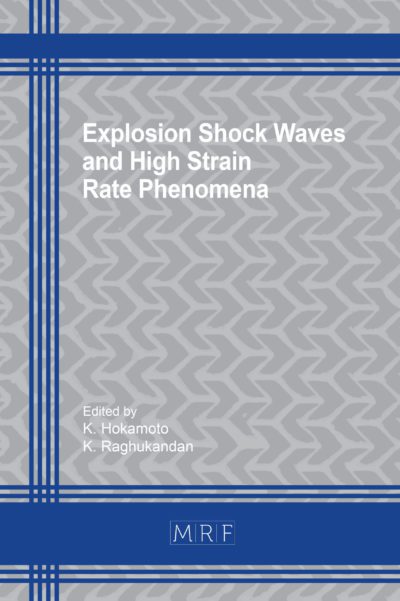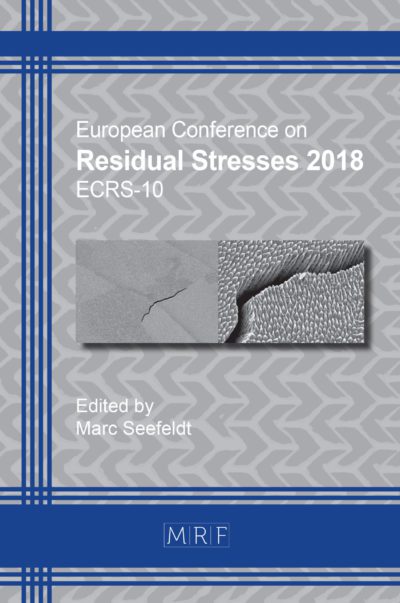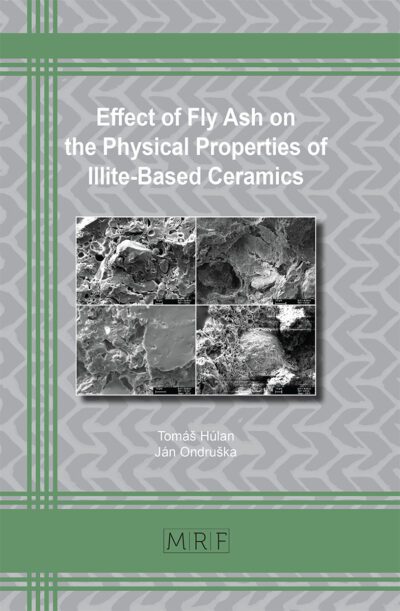Additive manufacturing of cermet produced by laser powder bed fusion using alternative Ni binder
PAPY Kevin, BORBELY Andras, SOVA Alexey, FAVRE Julien, BERTRAND Philippe, STAERCK Jean-Marc
download PDFAbstract. Cermets are composite materials made of a ceramic reinforcement and a metal matrix, generally cobalt as binder, with mass content from 6 to 20 wt.%. Cermets are produced by conventional sintering process and are known for their high hardness, low friction coefficient, high wear resistance, and high melting temperature. Laser Powder Bed Fusion (L-PBF) is an additive manufacturing technology widely applied for direct fabrication of functional metallic parts with complex geometry such as internal channels or lattices structures. Considering several studies, production of cermets by L-PBF process is challenging. Recent publications have demonstrated the feasibility to produce WC-Co parts by L-PBF combined with Hot Isostatic Pressure (HIP) heat-treatment. HIP process is sometimes additionally performed as post-treatment to remove defects. HIP is performed at high temperatures and isostatic pressures in a furnace [1]. In this study, following an experimental design a parametric optimization was conducted in order to maximize the mass density of WC-17Ni. Process parameters were compared to those used for WC-17Co parts from recent study [2]. To improve the printed specimen integrity, the as-built samples were heat-treated. As-built and HIP samples were analyzed and compared in terms of mass density, microstructure, crystallographic phases, and macro hardness.
Keywords
Cermet, Tungsten Carbide, Laser Powder Bed Fusion, Hot Isostatic Pressing, Microstructure, Hardness
Published online 4/19/2023, 10 pages
Copyright © 2023 by the author(s)
Published under license by Materials Research Forum LLC., Millersville PA, USA
Citation: PAPY Kevin, BORBELY Andras, SOVA Alexey, FAVRE Julien, BERTRAND Philippe, STAERCK Jean-Marc, Additive manufacturing of cermet produced by laser powder bed fusion using alternative Ni binder, Materials Research Proceedings, Vol. 28, pp 129-138, 2023
DOI: https://doi.org/10.21741/9781644902479-15
The article was published as article 15 of the book Material Forming
![]() Content from this work may be used under the terms of the Creative Commons Attribution 3.0 license. Any further distribution of this work must maintain attribution to the author(s) and the title of the work, journal citation and DOI.
Content from this work may be used under the terms of the Creative Commons Attribution 3.0 license. Any further distribution of this work must maintain attribution to the author(s) and the title of the work, journal citation and DOI.
References
[1] H.V. Atkinson, S. Davies, Fundamental aspects of hot isostatic pressing: An overview, Metall. Mater. Trans.: Physical Metallurgy and Materials Science 31A (2000) 2981-3000. https://doi.org/10.1007/s11661-000-0078-2
[2] K. Papy, S. Jean-Marc, S. Alexey, B. Andras, Additive Manufacturing feasibility of WC-17Co cermet parts by Laser Powder Bed Fusion, Procedia CIRP 111 (2022) 153-157. https://doi.org/10.1016/j.procir.2022.08.049
[3] E. Herderick, Additive manufacturing of metals: A review, Materials Science and Technology Conference and Exhibition 2011, MS and T’11 2 (2011) 1413–1425.
[4] N. Li, S. Huang, G. Zhang, R. Qin, W. Liu, H. Xiong, G. Shi, J. Blackburn, Progress in additive manufacturing on new materials: A review, J. Mater. Sci. Technol. 35 (2019) 242-269. https://doi.org/10.1016/j.jmst.2018.09.002
[5] B. Zhang, Y. Li, Q. Bai, Defect Formation Mechanisms in Selective Laser Melting: A Review, Chinese Journal of Mechanical Engineering (English Edition) 30 (2017) 515-527. https://doi.org/10.1007/s10033-017-0121-5
[6] S. Vock, B. Klöden, A. Kirchner, T. Weißgärber, B. Kieback, Powders for powder bed fusion: a review, Progress in Additive Manufacturing 4 (2019) 383-397. https://doi.org/10.1007/s40964-019-00078-6
[7] I. Gibson, B. Stucker, D. Rosen, Additive Manufacturing Technologies 3D Printing, Rapid Prototyping, and Direct Digital Manufacturing, Second Ed., Springer, New York, 2019. https://doi.org/10.1007/978-1-4939-2113-3
[8] C.Y. Yap, C.K. Chua, Z.L. Dong, Z.H. Liu, D.Q. Zhang, L.E. Loh, S.L. Sing, Review of selective laser melting: Materials and applications, Appl. Phys. Rev. 2 (2015) 041101. https://doi.org/10.1063/1.4935926
[9] L.N. Carter, M.M. Attallah, R.C. Reed, Laser Powder Bed Fabrication of Nickel-Base Superalloys: Influence of Parameters; Characterisation, Quantification and Mitigation of Cracking, 2012.
[10] C. Chen, Z. Guo, S. Li, Y. Xiao, B. Chai, J. Liu, Microstructure and properties of WC-17Co cermets prepared using different processing routes, Ceram. Int. 45 (2019) 9203-9210. https://doi.org/10.1016/j.ceramint.2019.01.265
[11] Z. Roulon, J.M. Missiaen, S. Lay, Carbide grain growth in cemented carbides sintered with alternative binders, Int. J. Refract. Metal. Hard Mater. 86 (2020) 105088. https://doi.org/10.1016/j.ijrmhm.2019.105088
[12] H.M. Ortner, P. Ettmayer, H. Kolaska, I. Smid, The history of the technological progress of hardmetals?, Int. J. Refract. Metals Hard Mater. 49 (2015) 3-8. https://doi.org/10.1016/j.ijrmhm.2014.04.016
[13] R.T. Faria, M.F. Rodrigues, I. de Andrade Esquef, H. Vargas, M. Filgueira, On the thermal characterization of a HPHT sintered WC-15% wt Co hardmetal alloy, Int. J. Refract. Metals Hard Mater. 23 (2005) 115-118. https://doi.org/10.1016/j.ijrmhm.2004.11.007
[14] A.S. Kurlov, A.A. Rempel’, Effect of sintering temperature on the phase composition and microhardness of WC-8 wt % Co cemented carbide, Inorganic Materials 43 (2007) 602-607. https://doi.org/10.1134/S002016850706009X
[15] C.M. Fernandes, A.M.R. Senos, Cemented carbide phase diagrams: A review, Int. J. Refract. Metals Hard Mater. 29 (2011) 405–418. https://doi.org/10.1016/j.ijrmhm.2011.02.004
[16] A. Aramian, S.M.J. Razavi, Z. Sadeghian, F. Berto, A review of additive manufacturing of cermets, Addit. Manuf. 33 (2020) 101130. https://doi.org/10.1016/j.addma.2020.101130
[17] Y. Yang, C. Zhang, D. Wang, L. Nie, D. Wellmann, Y. Tian, Additive manufacturing of WC-Co hardmetals: a review, Int. J. Adv. Manuf. Technol. 108 (2020) 1653-1673. https://doi.org/10.1007/s00170-020-05389-5
[18] T. Schwanekamp, Parameter study on laser beam melting of WC- Co at 800°C pre-heating temperature, ICAT Proceedings of 7th International Conference on Additive Technologies, no. October, pp. 78-84, 2019.
[19] D. Bricín, M. Ackermann, Z. Jansa, D. Kubátová, A. Kříž, Z. Špirit, J. Šafka, Development of the structure of cemented carbides during their processing by slm and hip, Metals 10 (2020) 1-17. https://doi.org/10.3390/met10111477
[20] J. Chen, M. Huang, Z.Z. Fang, M. Koopman, W. Liu, X. Deng, Z. Zhao, S. Chen, S. Wu,
J. Liu, W. Qi, Z. Wang, Microstructure analysis of high-density WC-Co composite prepared by one step selective laser melting, Int. J. Refract. Metals Hard Mater. 84 (2019) 104980. https://doi.org/10.1016/j.ijrmhm.2019.104980
[21] T. Schwanekamp, M. Reuber, Additive manufacutring of application optimized tungsten carbide precision tools, 6 th International Conference on Additive Technologies, January 2016, pp. 100–114, 2016. https://doi.org/10.1016/S0925-8388(03)00637-6
[22] T. Schwanekamp, Thermal Post-Treatment of Additively Manufactured WC-Co Processed by Laser Powder Bed Fusion, 2019.
[23] E. Uhlmann, A. Bergmann, W. Gridin, Investigation on Additive Manufacturing of Tungsten Carbide-cobalt by Selective Laser Melting, Procedia CIRP 35 (2015) 8-15. https://doi.org/10.1016/j.procir.2015.08.060
[24] D. Gu, W. Meiners, Microstructure characteristics and formation mechanisms of in situ WC cemented carbide based hardmetals prepared by Selective Laser Melting, Mater. Sci. Eng. A 527 (2010) 7585-7592. https://doi.org/10.1016/j.msea.2010.08.075
[25] D. Gu, Q. Jia, Novel crystal growth of in situ WC in selective laser-melted W – C – Ni ternary system, Journal of the American Ceramic Society 97 (2014) 684-687. https://doi.org/10.1111/jace.12828.
[26] D. Gu, In Situ WC-Cemented Carbide-Based Hardmetals by Selective Laser Melting (SLM) Additive Manufacturing (AM): Microstructure Characteristics and Formation Mechanisms, in Laser Additive Manufacturing of High-Performance Materials, Springer Berlin Heidelberg, 2015, pp. 151–173. https://doi.org/10.1007/978-3-662-46089-4_5
[27] Information on https://imagej.nih.gov/ij/ (accessed on 07 December 2022)
[28] Information on https://maud.radiographema.eu/ (accessed on 07 December 2022)
[29] “Hardmetals – Palmqvist toughness test – ISO28079.” 2009.
[30] H. Okamoto, C-W (Carbon-Tungsten), J. Phase Equilibria Diffus. 29 (2008) 543-544. https://doi.org/10.1007/s11669-008-9396-7














